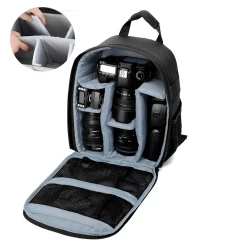Here are some common types of camera bags and their features
2024-03-22
Camera bags are essential accessories for photographers to safely transport and organize their camera gear, lenses, accessories, and personal items. These bags come in various styles, sizes, and designs to accommodate different types of cameras, equipment, and preferences. Here are some common types of camera bags and their features:
1. Shoulder Bags:
Design: Shoulder bags have a single strap and are worn over the shoulder or across the body for easy access to camera gear.
Organization: Typically feature padded compartments and dividers to protect and organize cameras, lenses, and accessories.
Pockets: Include exterior and interior pockets for storing memory cards, batteries, smartphones, and personal items.
Accessibility: Provide quick access to gear through top or side openings, ideal for photographers who need to capture spontaneous shots.
2. Backpacks:
Design: Backpack-style camera bags have two shoulder straps and are worn on the back, distributing weight evenly for comfortable carrying during travel or outdoor shoots.
Capacity: Available in various sizes to accommodate different amounts of camera gear, laptops, and personal items.
Organization: Feature multiple compartments, padded inserts, and adjustable dividers to organize cameras, lenses, tripods, and other accessories.
Comfort: Designed with padded shoulder straps, back panels, and waist belts for ergonomic support during extended wear.
Versatility: Some backpacks have removable camera inserts, converting them into regular backpacks for everyday use.
3. Sling Bags:
Design: Sling bags have a single strap and can be worn over one shoulder or across the body, allowing quick rotation to the front for easy access to gear.
Compactness: Offer a streamlined design for minimalistic carrying, suitable for photographers on the go or in crowded environments.
Accessibility: Provide rapid access to gear through a single zippered opening or side compartment, ideal for street photography or urban exploration.
Storage: Include interior and exterior pockets for organizing small accessories, water bottles, and personal items.
4. Rolling Cases:
Design: Rolling camera cases feature wheels and a retractable handle for easy transportation of heavy camera equipment during travel or on-location shoots.
Capacity: Offer spacious interiors with customizable compartments and dividers to protect and organize cameras, lenses, lighting equipment, and accessories.
Durability: Constructed from durable materials with reinforced corners and padded interiors to withstand rough handling and protect delicate gear.
Accessibility: Provide convenient access to gear through large zippered openings or clamshell designs, allowing photographers to work efficiently on location.
5. Holster Bags:
Design: Holster-style camera bags have a compact, streamlined design for carrying a single camera body with a lens attached.
Protection: Feature padded interiors and weather-resistant materials to protect the camera from scratches, dust, and moisture.
Accessibility: Provide quick access to the camera through a top or side opening, allowing photographers to capture shots rapidly.
Versatility: Can be worn on the hip or attached to a larger backpack or belt system for easy access and mobility.
6. Waist Packs:
Design: Waist packs, also known as hip bags or fanny packs, are worn around the waist and provide compact storage for a camera body and lens.
Convenience: Offer hands-free carrying and easy access to gear, making them suitable for photographers who need to move quickly and capture spontaneous shots.
Comfort: Feature padded waist belts and adjustable straps for comfortable wear during long shooting sessions.
Organization: Include interior dividers and pockets for organizing small accessories, memory cards, and batteries.
When choosing a camera bag, consider factors such as the type and amount of camera gear you need to carry, your shooting style, comfort preferences, and travel requirements. Look for bags with durable construction, ample padding, and customizable storage options to protect and organize your valuable camera equipment effectively.



